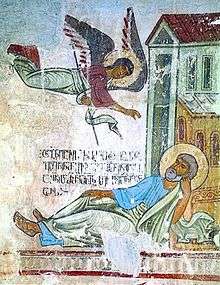Ateni Sioni Church
| Ateni Sioni Church ატენის სიონი (Georgian) | |
|---|---|
|
Ateni Sioni Church. | |
| Basic information | |
| Location |
Ateni, Shida Kartli Province (Mkhare), |
| Geographic coordinates | 41°54′14″N 44°05′46″E / 41.9039°N 44.0960°ECoordinates: 41°54′14″N 44°05′46″E / 41.9039°N 44.0960°E |
| Affiliation | Georgian Orthodox |
| Architectural description | |
| Architectural type | Church |
| Completed | 7th century |
The Ateni Sioni Church (Georgian: ატენის სიონი) is an early 7th-century Georgian Orthodox church in the village of Ateni, some 10 km (6.2 mi) south of the city of Gori, Georgia. It stands in a setting of the Tana River valley known not only for its historical monuments but also for its picturesque landscapes and wine. The name "Sioni" derives from Mount Zion at Jerusalem.
Sioni is an early example of a "four-apse church with four niches"[1] domed tetraconch (between the four apses are three-quarter cylindrical niches which are open to the central space). The church's cruciform interior measures 24m x 19.22m, and its façades are faced with carved rectangular greenish-gray stones, richly decorated with ornaments and figurative reliefs. The church is not dated but is very similar in design to the Jvari Monastery at Mtskheta, which is generally held to have preceded it, and, hence, has been described by some art historians as belonging to the "Jvari-type" group of churches.[2] Todosak, mentioned in an undated Armenian inscription on the southern facade as "I, Todosak, the builder of this holy church" is considered to have been an Armenian architect of the original church[3] or its late 10th-century renovator.[4]

The walls of the church contain the earliest known inscriptions in Nuskhuri or Nuskha-Khutsuri, one of the versions of the early Georgian alphabet, dating from 835. The earliest known examples of Mkhedruli, a currently used Georgian script, are also found in the Ateni Sioni church and date to the 980s. One of the inscriptions on the church commemorates Adarnase I of Tao-Klarjeti, the first documented Georgian Bagratid nobleman who was the father of Ashot I, the founder of the new royal line of Georgia.[5]
Near the church there are the ruins of the medieval fortified town of Ateni (modern-day villages of Didi Ateni and Patara Ateni).
References
- ↑ Patrick Donabedian & J.-M. Thierry, Armenian Art, New York 1989, p.67.
- ↑ Wachtang Beridse, Die Baukunst des Mittelalters in Georgien, Berlin 1980, p.27.
- ↑ Patrick Donabedian & J.-M. Thierry, Armenian Art, New York 1989, p.499.
- ↑ Rapp, Stephen H. (1997), Imagining history at the crossroads: Persia, Byzantium, and the architects of the written Georgian past, p. 648. Armenian Research Center collection, University of Michigan.
- ↑ Rapp, Stephen H. (2003), Studies In Medieval Georgian Historiography: Early Texts And Eurasian Contexts, p. 383. Peeters Bvba ISBN 90-429-1318-5.
External links
| Wikimedia Commons has media related to Ateni Sioni Church. |